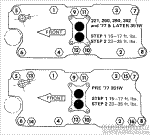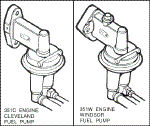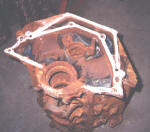The quickest way of differentiating
between the different familys of Ford engines is to simply count the
valve cover bolts.
- 2 bolts: 239/256/272/292/312
(produced from 1954 to 1964)
- 5 bolts:
332/352/360/361/390/391/406/410/427/428 (FE engine)
- 6 bolts: 221/260/289/302/351W
- 7 bolts: 429/460
- 8 bolts: 351C/351M/400
|

The early 351W has four extra intake
manifold bolts (13, 14, 15 and 16). If you see them, it's
definitely a 351W.
(Click to enlarge) |
Windsor engine characteristics
-
Thermostat housing bolted to the front of the intake manifold
-
All 289/302/351's
have intake bolts 90 degrees to the ground
-
289/302/351's have evenly spaced
exhausts aimed 90 degrees from length of head
-
5/8"
(18mm) spark plugs
-
The 351W and 302 are
very different:
-
The 351W has
a taller deck height than the 302. (a
302 will have the intake almost flush with the base of the
distributor... where it goes into the block..... a
351w will have about 1/2 inch lip there where the intake meets
the block.)
-
Since the deck height is taller the intake manifold is
wider on the 351w than on the 302.
-
The 351W uses a
larger main journal than the 302. there are 2 physical ways of telling
a 302 vs. a 351w. Also, in
between the frost plugs on a 351W
there will be what appears to be a triangle or diamond (the way
I was told) indented cast into the block...a
302 doesn't have those.
-
a 351W
is wider between the heads compared to a
302 (the intake manifold is wider by about 1-1/2")
and 351 pistons have a different pin height. You can use
302 pistons in a 351 if you stroke it to a 393
-
quick ID tip:
The lower thermostat housing bolt on
the 302 will be below the top of the water pump and you won't be able
to put a socket on it. On the 351W you can remove the bolt with a
socket.
|

Comparison of the 351C vs. the 351W fuel pumps
(Click to enlarge) |
Cleveland engine characteristics
-
The thermostat housing is on the block extension which contains
the timing chain
-
deck height makes a 351c intake not
fit on a 400, Spacer plates are available to use a 351C intake on a
351M/400, but it's more practical to use these mainly for large port
intakes on 400s using 351C 4V heads.
-
351C manifolds are dry, no water
passages or thermostat housing....thermostat housing goes into the
front of the block.
-
spark plugs will be the smaller 14mm
type
-
The Cleveland (351C) has the small 300/302/351W
bell housing pattern.
-
The
302C is a de-stroked Cleveland, the block is identical to
a 351C, but the crank rods and pistons are all engine specific. The
302C heads are the small combustion chamber, small runner heads.
M-series (335) engine characteristics
-
The 351M/400 was only available with
small ports, same as 351C 2V. An Edelbrock Performer for these are
wider and should say Performer 400 on the top.
-
351M/400 manifolds are dry, no water
passages or thermostat housing.
-
There is about a 1" rib cast onto
the block on the taller 351M/400 which runs along side the distributor
going from the front of the block extension back to the intake
manifold.
|

This
is a very rare Ford 400 block, one of a very few cast to fit the
standard Cleveland bellhousing. These blocks have blank engine
mount bosses which can be drilled to suit standard Cleveland
engine mounts making them a direct replacement for a 351C
(assuming no height/width problems). |
-
All engines in the 335 series
(family) have the vertical bolt pattern on the fuel pump. That
includes 351C, 351M, and 400.
-
M-block engines have the taller
intake manifold front mating surface (almost an inch above the
distributor mounting hole and front cover housing) and is quite
apparent
-
The only real
differences between a 351M and a 400 are the crank and the pistons.
-
351M and 400 heads are identical, are also nearly identical to 2V Cleveland
heads
-
The 351M
and almost all 400's have the large bell housing pattern like
the 429/460.
-
The only 100% positive way to tell if you have a
351M or 400 is to drop the oil pan and check the casting
numbers on the crank. They should be on the side of the first
counterweight. A 400 crank will have 5M, 5MA or 5MAB casting code. A 351M crank will have a 1K casting code.
-
400 with
302 bellhousing was made in '73, and will also have the
regular 400 bellhousing mount casting. Top 2 bellhousing bolt holes
are 5 inches apart on a 302, 7 3/4 inches on 400. (see image at right)
FE/FT engine characteristics
-
Just take a glance at the seam where
the intake and the head come together to make up the sealing surface
for the valve covers. The FE/FT intakes are so wide that they go
underneath the valve covers a bit. No bolt counting necessary. No
other vintage Ford engines have this characteristic. One other
characteristic is the skirted block. These blocks are flat on the
bottom and the oil pan mating surface is 100% flat (no humps).
- Intake bolts are perpendicular to
intake face or roughly 45 degrees to the ground
-
exhaust ports are raised up from the
bolt plane of the lower head; runners are somewhat doglegged with
front 2 angled towards rear and back 2 angled towards front of car
-
The "352" casting appears on the
outside of many (if not most) FE engine blocks on the rear of the
block (behind the flywheel), with no regard to the real displacement.
So a "352" block could really be a 332, 352, 390, 410, etc.. Measuring
bore and stroke is the best way to confirm the actual engine
displacement.
-
Swapping in a 390 crank and rods
turns a 360 into a 390, restores quench and compression, and makes the
engine into a real performer. It's a HIGHLY recommended upgrade. Both
engines are neutral balanced, so the flywheels and harmonic dampeners
are interchangeable. The ONLY things that need swapped to make the
change are the crank and rods. They even use the SAME replacement
pistons. However, if you have the original full skirt pistons from the
361, they will interfere with the rods when bolted to the 390 crank.
No 360 ever came with full skirts, only the 361, and not the FT
either. The Edsel used a version of the 352 with a .050 bigger bore
that had the full skirt. To use a full skirt on a 390 crank the only
thing needed is a slight trimming of the end pistons, or the end
counterweights in just a small spot that would be barely noticeable.
Just the outside weights in one spot are near. The piston only needs
about an 1/8th inch off one side of the skirt.
385 series
(Lima) engine
characteristics -
(includes 370, 429, 460)
- If the thermostat housing points up and is
on the intake it would be a 460
MISC.
- 351C has motormounts and bellhousing
pattern like a 302, 351W, 240/300 CID.
- 351M-400 has motormounts and
bellhousing pattern like a 460
Identifying a straight six
The 300 was first available in '65. The casting number on the block
is the same for 240s and 300s, so you can't use that to determine the
CID. However, you can at least determine it's year of manufacture...or
at least the date the block was cast.
Find the casting # on the passenger side of
the block. It would be something like C5TE or D7TE or E1TE. The first
letter is the decade.
- C=60's
- D=70's
- E=80's
- F=90's
The second digit is the year. C5TE = 1965...
Note: Some casting #'s were used in more then the one year but they will
tell you what age the engine is. Also... All 67-86 engine rebuild kits
are interchangeable and then all 87-96 are also interchangeable
To determine the CID you'll have to measure the stroke. Pull the #1 spark plug and stick a
stiff piece of wire down into the the cylinder until it contacts the top
of the piston. Then manually rotate the engine around until the piston
is as low as it will go in the cylinder (BDC). Make a mark on the wire
at some reference point, like a valve cover lip. Then manually rotate
the engine around until the piston is as high as it will come (TDC) and
make another mark. One thing you'll need to pay special attention to is
the position of your measuring wire on the piston top. The dished
pistons, combined with the fact that your wire will be going in at a
slight angle, mean you need to try to keep your wire in the center of
the piston dish and at the same angle as it comes up in the bore.
Now you can compare your marks to find the stroke. A 240 has a
3.18" stroke, 300 is 3.98". Your measurements will probably be a tad
longer than these, due to normal error and the varying angle of the
measuring wire as it emerges from the spark plug hole. Removing the
heads and measuring the stroke is much more accurate.
Look at the casting number on the passengers
side of the motor in the back. It'll start with a letter, then a number,
then two letters, either AE or TE (example: C7TE or C7AE) If it ends in
TE then the motor was originally in a truck. If it ends in AE it was
originally in a car. The 240 was found in cars and trucks, the 300
trucks only. If the third and 4th digits are AE then the block was
originally meant to be a 240 from the factory. Of course it could have
had internals swapped, the 300 line could have been running short on
blocks so a 240 block made its way to keep the line going.
The other methods of determining your engine CID are more difficult,
which include dropping the oil pan to check the crankshaft numbers.
200's have a different bellhousing pattern then the big truck sixes
(240/300).
Check out
http://fordsix.com
|